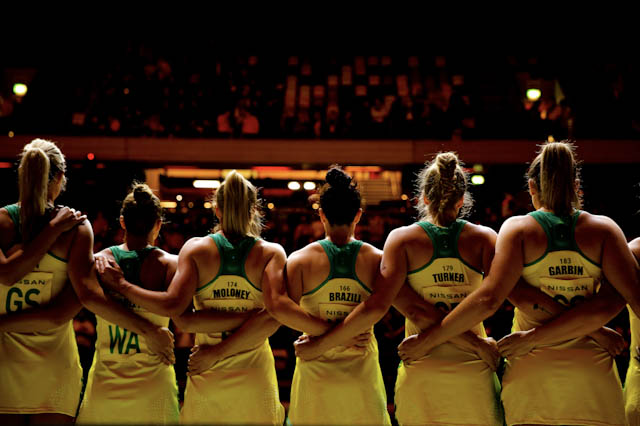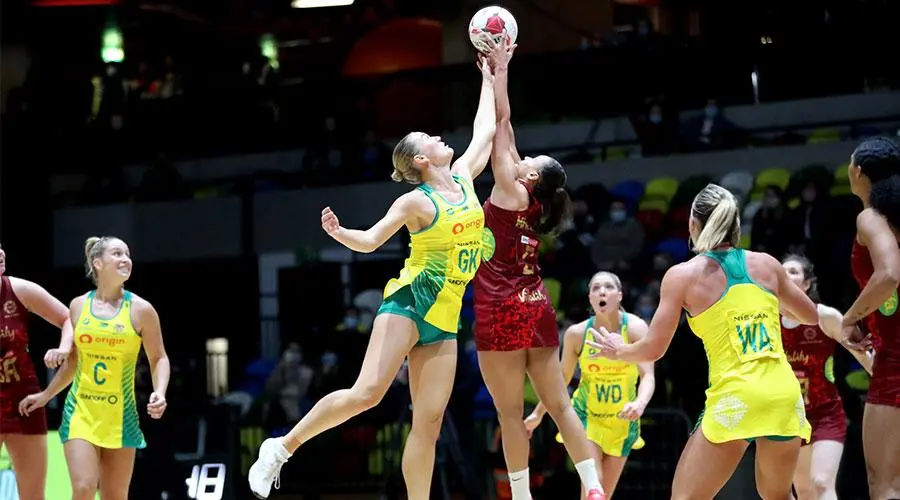
2022 Quad Series – Round 3
Contributors: Katrina Nissen, Ian Harkin, Jenny Sinclair, Andrew Kennedy
SOUTH AFRICAN SPAR PROTEAS v NEW ZEALAND SILVER FERNS
New Zealand 54 def South Africa 43
Starting Line Ups:
South Africa:
GS – Ine Mari Venter
GA – Lefebre Rademan
WA – Izette Griesel
C – Bongi Msomi
WD – Monique Reyneke
GD – Zanele Vimbela
GK – Phumza Maweni
New Zealand:
GS – Grace Nweke
GA – Maia Wilson
WA – Gina Crampton
C – Shannon Saunders
WD – Karin Burger
GD – Phoenix Karaka
GK – Sulu Fitzpatrick
Player of the Match: Phoenix Karaka (New Zealand)
Shooting Percentages:
South Africa:
Ine-Mari Venter 31/36 (86%), Lefebre Rademan 7/10 (70%), Sigi Burger 5/5 (100%)
New Zealand:
Grace Nweke 30/32 (94%), Maia Wilson 9/13 (69%), Tiana Metuarau 15/16 (94%),
Umpires: Gary Burgess and Kate Stephenson with Louise Travis
Milestones:
Mila Reuelu-Buchanan made her Silver Ferns debut becoming Fern number 181.
Talking Points:
Tired bodies were on show in this match which can only be described as sloppy. The turnovers and silly mistakes from both teams were high.
Unusually, the Silver Ferns have been the most penalised team in the series to date. Their space marking style and off-body approach usually keep penalties low, a trademark that Noeline Taurua-coached teams are known for. In the game against South Africa, the Silver Ferns were able to reduce their penalty count to 39, on par with England, and just a few cleaner than Australia’s 44.
In Round 1, Kaylia Johnson contributed 11 and Karin Burger 15. In Round 2, Johnson was responsible for 15, Kelly Jury for 16, while Burger tidied up to just 7. In Round 3, neither Johnson nor Jury played, while Burger had just 6 penalties recorded against her. So it will be fascinating to see if Johnson and Jury appear in the bronze medal match, and if so, what their penalty counts might be, and how it will impact the game.
Bongi Msomi has been consistent for her side throughout the Quad Series. Image: Ben Lumley
Stand out Players:
It’s no surprise the game MVP, Phoenix Karaka was a standout for the Ferns. She played a clean match, coming off the body to get her feet around the opposition. She was disruptive and switched beautifully with her defensive partner Sulu Fitzpatrick.
After a shaky game in her previous outing, Grace Nweke was a dominant target at goal shooter for New Zealand, with 30/32 in three quarters of netball, while Tiana Metuarau also played well in her 39 minutes on court.
Once again, captain Bongi Msomi was in everything at centre for South Africa, with 38 feeds and 22 goal assists, including nine in the final quarter which was the Proteas’ best.
Interesting Statistics:
The lack of defensive experience in the South African side was evident tonight. The Silver Ferns had 17 gains compared to the Proteas 7. Match MVP, Phoenix Karaka took 6 of those, with the rest being spread down the court including shooters Grace Nweke (2) and Tiana Metuarau (3).
The Silver Ferns also led the deflections with 22 for the game to the Proteas 6. Again, this pressure was applied all the way down the court with almost every athlete getting a hand to the ball at one point.
Of particular disappointment for the Proteas would be their inability to convert gains into goals, with their rate languishing at 29% compared to the Silver Ferns 82%.

The Roses will take on Australia in the gold medal match. Image: Ben Lumley
ENGLAND ROSES v AUSTRALIAN DIAMONDS
England 48 drew with Australia 48
Starting Line Ups:
England:
GS – Ellie Cardwell
GA – Helen Housby
WA – Nat Metcalf
C – Jade Clarke
WD – Serena Guthrie
GD – Layla Guscoth
GK – Eboni Usoro-Brown
Australia:
GS – Cara Koenen
GA – Steph Wood
WA – Liz Watson
C – Jamie-Lee Price
WD – Ash Brazill
GD – Jo Weston
GK – Sarah Klau
Player of the Match: Ellie Cardwell (England)
Shooting Percentages:
England:
Helen Housby 22/24 (92%), Eleanor Cardwell 26/30 (87%)
Australia:
Sophie Garbin 18/20 (90%), Gretel Bueta 7/9 (78%), Steph Wood 10/12 (83%), Cara Koenan 13/16 (81%)
Umpires: Anso Kemp and Alison Harrison with Elizna Van Den Berg
Milestones:
Australian Diamonds captain Liz Watson became the 30th Australian athlete to notch up 50 test caps.
Talking Points:
It was the first draw of the series, with the Diamonds squandering a six goal lead at the end of the third quarter. As they’ve learned to do so well, the Roses fought back hard in the final minutes of the match, drawing level in the final seconds of the game. However, Australia didn’t look like they used their strongest line up at any point in the game, targeting combinations and testing players ahead of Commonwealth Games selection.
The shooting circle is proving to be an interesting conundrum for the Diamonds. In the first half, the familiar Lightning combination of Cara Koenen and Steph Wood was used, with all of Wood’s wiles needed to help craft the ball into the circle. The duo finished with a combined 23 goals at 82%, with Koenen giving away three turnovers.
In the second half, Sophie Garbin and Gretel Bueta took the court for just their second hit out together. There’s a lot to like about this pairing: their strength under the post, aerial ability, and added defensive capability show promising signs for the future. They slotted 25 goals at 84%, with Garbin giving away four turnovers. It was also evident that Jamie-Lee Price found it considerably clearer to spot Garbin’s hold compared to any of the other more mobile shooters, as she was repeatedly able to find pinpoint feeds from well off the circle and between two defenders.
Steph Wood is an undoubted game changer, so it potentially could be fascinating to see what a Garbin/Bueta/Wood/Watson front line could do – one of the few combinations that is yet to be tested in this series. In this match she was vital in taking control of the centre channel while also resetting and performing triple or quadruple plays with the feeders.
Diamonds coach, Stacey Marinkovich spoke after the match about the rotation of her athletes stating, “I think I’ve got a variety of combos we can certainly go to. We’ll have to see how the girls pull up in the morning, but for all intents and purposes part of the reason of being over here is to see the versatility that we’ve got. I think we saw some real strength in the combinations that we put out there, and there were some changes that we had to make on the fly. You can just see the growth and strength across all of them when they’re coming on; it’s improving each time.”

Hear more from the coaches and captains, thanks to our friends at The Netball Show in their Day 3 wrap.
The Diamonds defence swarmed the Roses at the start of the match, and were particularly effective in swatting the ball around the Roses shooting circle edge.
In the broadcast, Cath Cox confirmed that youngster Sophie Dwyer has not got on the court for the Diamonds yet because Stacey Marinkovich wanted to give existing combinations more time to solidify. In contrast, newbie Sunday Aryang got a second test cap at goal defence. While her assistance in attack is calm and solid, and her tracking is generally good through court, the more experienced English shooters had tricks and rotation that often saw her a step behind the pace inside the circle itself.
England started at close to full strength throughout most of the court, although bookends Geva Mentor (bench) and Jo Harten (unavailable), weren’t part of the starting seven. Midcourt selection for the Commonwealth Games is a hot contest, and Jess Thirlby used the match to trial a range of combinations. Natalie Metcalf, Laura Malcolm and Sophie Drakeford-Lewis were all used at wing attack, Jade Clarke and Malcolm at centre, and Serena Guthrie and Beth Cobden at wing defence. All of the combinations had their patches of brilliance, but the Australians were able to swamp them in defence a lot of the match.
Metcalf and Guthrie have their seats booked, while it’s likely that Cobden will also be in the mix. The foot race for the final midcourt place looks like it will be between Malcolm and Clarke, who both offer different strengths. Clarke is a steady head and sure pair of hands, although it’s disappointing not to see her trialed at wing attack, which she has played successfully before. Malcolm has been given the opportunity to run across three positions, and while she appears to be more versatile, and attacks the circle edge well, doesn’t have the big game experience of Clarke.
This may also hinge on whether traditional goal attack Sophie Drakeford-Lewis is picked, since she played a very different and handy wing attack game in this match, thereby covering two positions ably. Given England’s history across all codes of sport to rely on veterans rather than trust youth, we may see the 38-year old Clarke get up to nearly 200 tests this year in Birmingham.
Eboni Usoro-Brown was given the start at goal keeper ahead of Geva Mentor, but was heavily sanctioned by the umpires. She gave away 11 penalties in her 30 minutes on court, compared to Mentor’s three. Layla Guscoth was probably the pick of the Roses defenders, with controlled passion, wonderful speed and stamina, and good timing, picking up multiple balls in the final quarter. She was replaced for the last four minutes by Stacey Francis-Bayman, whose fresh legs and endless experience playing in Suncorp Super Netball proved a clever substitution.
Francis-Bayman was told to heavily double-team Garbin, and thus despite several shooting attempts, Australia was scoreless in the last three minutes while England managed three goals. It may well have been the nous of Mentor in deliberately running into the post and making it wobble that was the key, as Bueta’s easy close shot bounced out; the next attempt, the Roses goal keeper had such a perfect lean over Garbin’s shot that it was an air ball.
With 45 seconds to go, Bruce took an amazing intercept, and the Diamonds penetrated quickly down court. Unbelievably, it was a questionable stepping call against their captain Liz Watson that gave England 25 seconds to score and level the match, thanks to Housby.
The umpiring of the match was very consistent. Given the pressure of this game, the experienced Kemp and newcomer Harrison, while letting physical clashes play out and also missing a lot of contact off the ball, were sharp and specific in the defensive circles and made very few controversial calls, without losing control and not needing to issue cautions and warnings. Harrison in particular would give tips to players to stop offending when the ball was at the other end of the court.
Stand out Players:
Once again Helen Housby delivered in a clutch moment, to sink the goal which drew the match. She had a quiet first half to the match but worked into it in the second. In the fourth quarter particularly, even with a very junior feeding combination of Malcolm and Drakeford-Lewis, it was her dodges and elusiveness that saw her dominate both Klau and then Bruce.
Sarah Klau stamped her mark on the game in the first quarter, coming up with all of her match high five gains in just 15 minutes. She took advantage of the overt desire of the Roses feeders to quickly feed to a one-on-one, when Cardwell had no real space to drop into. The switch between Cardwell and Housby at the start of the second quarter proved more of a challenge for the Australian keeper, who with no further gains, was substituted in the final term when Housby cut loose.

Courtney Bruce was impressive in her limited time on the court. Image: Netball Australia
Courtney Bruce came up with 2 gains in her 10 minutes on court, although the 35 minute period between gains will undoubtedly be looked at. Cardwell’s form has improved radically in two years – she is now dictating play, and like Bueta is a fairly unique player. The Rose has imposing physical presence, great holds and accuracy at goal shooter, but is fit and fast at goal attack, and her passes are hard, smart, flat, and decisive. Her height gives her good vision and confidence to feed from well off the circle, and she is willing and accurate in long range shooting.
For Australia, Liz Watson was marked by two world class wing defences in Serena Guthrie and Beth Cobden, but worked hard throughout the match. She finished with 16 centre pass receives and 18 feeds, in her 50th test match for Australia.
Interesting Statistics:
Australia didn’t appear to run their strongest line at any point in the game, and statistically speaking, there’s room for improvement. While they nudged the Roses 65% to 55% in their ability to score from a centre pass – a worryingly low percentage from both sides – they were on the wrong end of the margin in two other key measures.
They converted just 60% of their gains to goal (Roses 71%) and just 54% of their turnovers to goal (Roses 73%).
Kate Moloney (Australia) applied plenty of pressure to her opponent, but with five turnovers for no gains, it perhaps wasn’t the outing she would have liked at wing defence. Australia’s midcourt gave away 13 of their sides 26 turnovers, another figure that they will be keen to address before the final.
What’s next
In the finals series played this evening, home town favourites, the English Roses will take on Australia for gold, while New Zealand will revisit their match against the Proteas.
The Road to Birmingham 2022
Today’s matches in the quad Series appeared to answer some questions, but also raise some others, so let’s go through each team and see if we can work out what the selectors will do.
Firstly, to the home side, English shooter Sophie Drakeford-Lewis today displayed her point of difference, by playing a starring role at wing attack in the Roses’ fightback. Ellie Cardwell and Helen Housby also showed their versatility. So, if the selectors are wanting more options, then it could mean that George Fisher will be the unlucky one to miss out.
With Jo Harten to come back, a shooting lineup of Harten, Cardwell, Housby and Drakeford-Lewis would have three positions well covered. It will be interesting to see who Jess Thirlby goes with in tomorrow’s final. That may give us a hint as to her thinking.
On to Australia, and there are two main selection battles going on. In defence, Sarah Klau, Courtney Bruce and Jo Weston have three positions sewn up, leaving Maddy Turner and Sunday Aryang to fight it out for the other spot. Aryang was given a good hitout today, but perhaps Turner just has the front running.
The other selection headache is in the midcourt. Again, it would seem that Liz Watson, Paige Hadley and Ash Brazill are shoe-ins. So that means it is Kate Moloney versus Jamie-Lee Price for the fourth pick. Maybe Price has her nose in front in that one.
With both of these decisions, we may learn a bit more simply by seeing which players are chosen in the 12 for tomorrow’s final. However, it will also be fascinating to see how the domestic season unfolds, and whether there’s a sniff of opportunity for former Diamonds Kim Ravaillion or Kelsey Browne. Neither Price, nor Moloney has performed outstandingly here.
For New Zealand, the big news today was the form of Phoenix Karaka. She was tremendous and her performance must have helped her cause greatly. Mila Reuelu-Buchanan played her first test and had a fine game. She may now be added to the mix for the centre position where there has been no standout so far.
Grace Nweke looked strong and no doubt confirmed her position as one of the shooters for Birmingham, if there was any doubt. Assuming Ameliaranne Ekenasio returns, it seems certain she will join Nweke, Tiana Metuarau and Maia Wilson in a solid looking shooting combination.
The shooting difficulties continue for South Africa though. While Lenize Potgieter potentially comes back into the mix for Birmingham, the goal shooter position is not the main area of concern. It’s at goal attack where the problems lie. They’ve been unable to find a consistent play-maker in this position since the retirement of Maryka Holtzhausen.
Lefebre Rademan has been unable to nail down that spot. The attack looked better when she was on court today, but her shooting accuracy can go off, and when it does, she is often quickly replaced. The use of two tall shooters did not work today, and it is unlikely to work against any of the top teams. Unfortunately this is one problem that will be hard to fix, come Commonwealth Games time.

